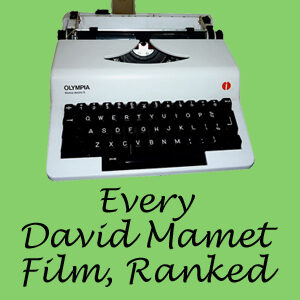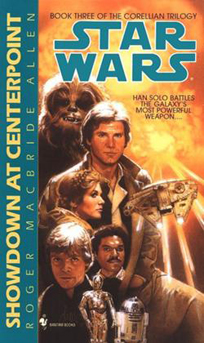Roger McBride Allen wraps up his “Corellian Trilogy” with “Showdown at Centerpoint” (1995), another installment that’s padded despite leaving a lot of interesting ideas on the table, but can’t totally be dismissed since it introduces a lot of important characters and elements to the Expanded Universe.
Like the first two books, the readability is up and down. A couple of action sequences are endless. Han crash-lands a coneship on Selonia; and Luke, Lando and company narrowly escape a heat storm in Centerpoint Station’s Hollowtown. Even though this was at the end of the timeline at the time it was written, I didn’t fear much for the fates of the main characters. Still, I admit to some surprise at the killing off of one fairly major character in the final space battle.
Aside from those action sequences, cover to cover, “Centerpoint” is about plotting. It’s almost as if Allen gets tired of characterization once he introduces the characters. For example, Ebrihim and Marcha become generic caretakers of the Solo kids in this book rather than providing uniquely Drall perspectives, as they did in previous books. And Allen gives lip service to the idea that Q9 and C-3PO bicker, but he never says what about.
For those reading the adult novels but not the “Young Jedi Knights” series, the Corellian trilogy has the deepest writing – such as it is – about the Solo kids. We see the closeness of the twins’ bond and how they both look after Anakin, who is always a bit aloof. Through the Force, Anakin understands how machines work, but, being 7 years old, he’s not good at communicating that to other people. In “Centerpoint,” Jacen is portrayed as a good pilot and Jaina as a good gunner. In later books, Jaina will be portrayed as taking after her dad as a pilot and warrior whereas Jacen takes after his mom in preferring diplomatic strategies.
The most curiously disappointing aspect of the Corellian trilogy is that Allen introduces, but doesn’t provide answers to, the mystery of the Corellian system’s birth: All of the planets have repulsors that moved them here from elsewhere. Plus, there’s Centerpoint Station, which seems kind of like a big battery that coordinated the whole endeavor. This is very much a sci-fi premise in Allen’s wheelhouse, to judge by his genre-laden resume up to this point, but none of these mysteries are investigated, let alone solved.
Other authors would pick up these threads (“Legacy of the Force” chronicled another Corellia-versus-New Republic civil war, and characters investigate Centerpoint further in “Fate of the Jedi”), but it’s kind of inexcusable that an entire trilogy fails to introduce even basic clues about the system’s creation.
Another oddity of the Corellian trilogy is that a face is never put on the major villain. Thrackan Sal-Solo is a lower-level villain in the whole scheme who is defeated by the children. But Sal-Solo’s string-pullers, who bring in a fleet from Sacorria, are little more than cannon fodder for the inevitable final space battle (which is written in cartoony fashion, although I appreciate that it doesn’t take up too many pages).

The “Corellian Trilogy” introduces us to Han’s wicked cousin, his home system and the mystery of its creation; it fleshes out the Solo children; and it features the debut of Lando’s future wife Tendra Risant and New Republic intelligence Belindi Kalenda, both of whom would play roles in later books. Still, while it’s mostly an easy read (and not as embarrassingly bad as say, Kevin J. Anderson’s adult books), it’s not particularly deep, and I can’t rank it as an essential series for anyone other than “Star Wars” completists.

